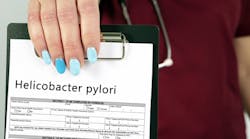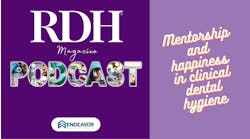As the COVID-19 pandemic settled, my stomach seemed to unsettle. The bloating, weight gain, and constant gnawing of my stomach began to worry me, but it wasn’t until I also developed a severe constant sore throat that I found myself seeking a doctor’s help.
After begging for all possible tests to help determine what my body was fighting, I was sent to an ear, nose, and throat physician who recommended I see a gastroenterologist to help me with acid reflux, which could be related to my sore throat. I took acid reflux medications for weeks with no relief for any of my symptoms. Finally, after I sought many medical opinions, a nurse practitioner recommended I be checked for H. pylori.
I had never heard of H. pylori outside of anatomy or biology classes. Helicobacter pylori (H. pylori) is a type of bacteria that can inhabit the stomach lining and is commonly associated with causing gastric ulcers and chronic gastritis. In fact, it is estimated that around half of the world's population is infected with H. pylori.1 Despite its prevalence, many people infected with it may not experience symptoms or health issues. Unfortunately, that was not the case for me as my symptoms intensified.
Testing and treatment
Testing for H. pylori infection can be done through various methods, and the choice of test may depend on the patient's symptoms, medical history, and availability of resources.2 There are noninvasive options such as stool antigen testing, urea breath testing, and blood tests. There are also invasive testing options such as endoscopy with biopsy and endoscopy rapid urease testing.
You might also be interested in: Do you really know what oral-systemic means?
My physician recommended urea breath testing. This was a simple test that collected a base sample of exhaled breath and then another sample after I ingested a solution containing a special type of urea labeled with a specific isotope. If H. pylori is in the stomach, it will break down the urea into carbon dioxide, and the exhaled breath can be analyzed for the presence of the isotope. Results are available one to two days after testing; my result was positive. I was happy to finally get an answer, and at that point how to treat this bacterial overgrowth became my primary focus.
Treatment for H. pylori can be intense and harsh at times. It involves a combination of antibiotics and acid-reducing medications, known as triple therapy—two antibiotics and one proton-pump inhibitor—or quadruple therapy, depending on the specific regimen used.3 The goal of treatment is to eradicate the H. pylori bacteria and promote healing of any associated gastrointestinal conditions, such as gastritis or peptic ulcers.
The choice of antibiotics and the duration of treatment may vary depending on factors such as local antibiotic resistance patterns and individual patient factors. In my case, I was given clarithromycin, amoxicillin, and a proton-pump inhibitor for 14 days. The treatment may cause changes in the oral microbiota and lead to side effects like dry mouth or oral candidiasis. Testing is repeated several weeks after treatment is complete. There is a high recurrence rate for H. pylori infection.
Links between H. pylori and oral health
While the primary effects of H. pylori are on gastrointestinal health, there have been some studies exploring its potential links to oral health. One of the main concerns related to oral health is the possibility of H. pylori transmission through the mouth. H. pylori is primarily transmitted through fecal-oral or oral-oral routes; some research has suggested that the bacteria can also be present in the oral cavity. This has raised concerns about potential transmission of the bacterium through kissing or other close contact with an infected person's oral secretions.4
Several studies have linked H. pylori to halitosis.5 The bacteria can produce volatile sulfur compounds that contribute to foul-smelling breath. Other studies have even explored the presence of H. pylori in oral lesions, particularly in cases of stomatitis, gingivitis, and periodontitis. However, the direct role of H. pylori in causing these oral conditions still needs further research to determine statistical significance.
Reviewing your patient's medical history and obtaining updates at every appointment are crucial to care. Knowing the possible oral implications that come with H. pylori can allow clinicians to better tailor home care, such as incorporating a dry mouth rinse and tongue scrapers. It can also be helpful to patients who complain about halitosis to visit their primary care physician and determine the possibility of testing for H. pylori.
References
- Salih BA. Helicobacter pylori infection in developing countries: the burden for how long? Saudi J Gastroenterol. 2009;15(3):201-207. doi:10.4103/1319-3767.54743
- Dore MP, Pes GM. What is new in Helicobacter pylori diagnosis. An overview. J Clin Med. 2021;10(10):2091. doi:10.3390/jcm10102091
- Chen YI, Fallone CA. A 14-day course of triple therapy is superior to a 10-day course for the eradication of Helicobacter pylori: a Canadian study conducted in a 'real world' setting. Can J Gastroenterol Hepatol. 2015;29(8), e7-e10. doi:10.1155/2015/659390
- Abdul NS, Khalid Alkhelaiwi A, Awadh Alenazi A, Fehaid Alrashidi R, Ghaleb Salma R. The association of Helicobacter pylori in the oral cavity with dental caries in patients with and without gastric infection: a systematic review. Cureus. 2023;15(5):e38398. doi:10.7759/cureus.38398
- Anbari F, Ashouri Moghaddam A, Sabeti E, Khodabakhshi, A. Halitosis: Helicobacter pylori or oral factors. Helicobacter. 2019;24(1):e12556. doi:10.1111/hel.12556






